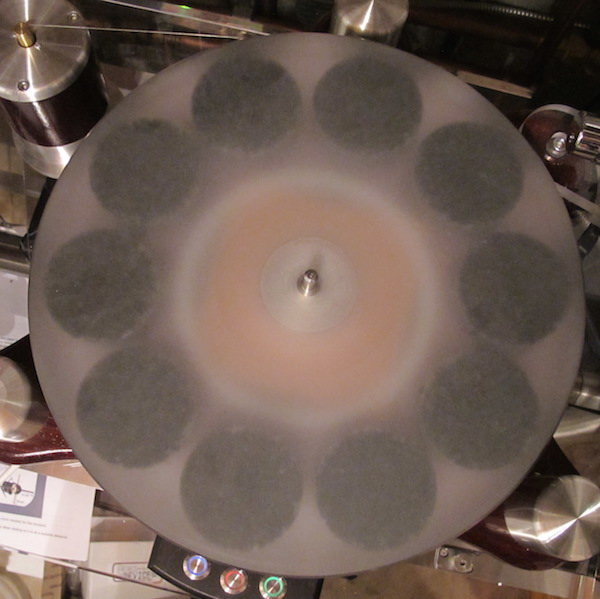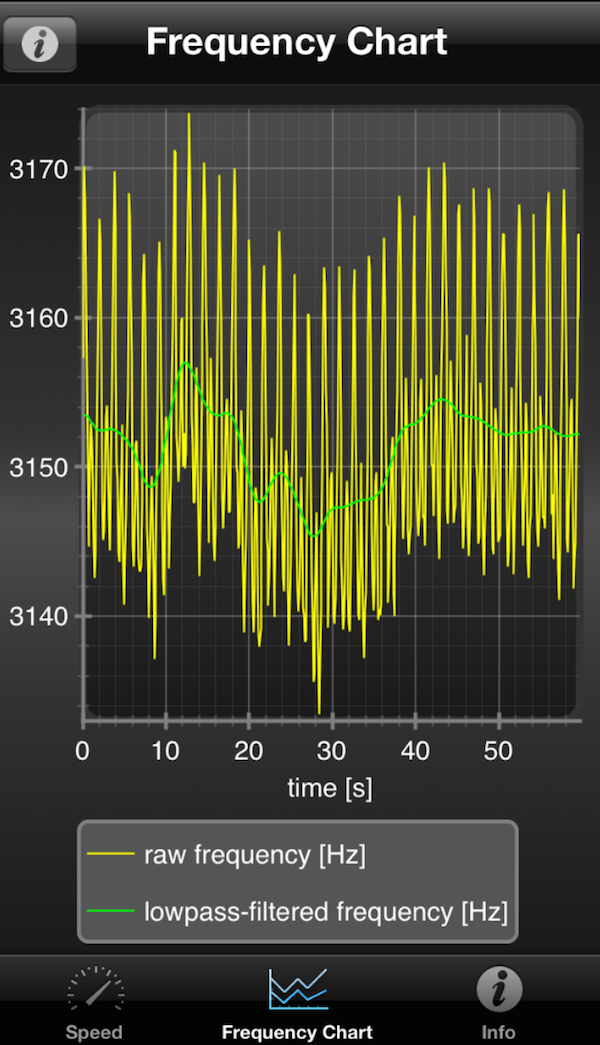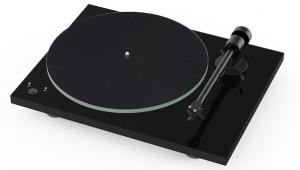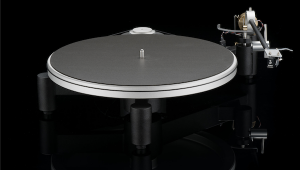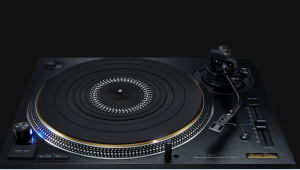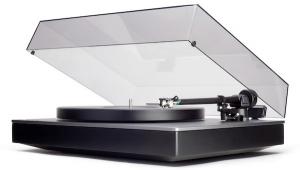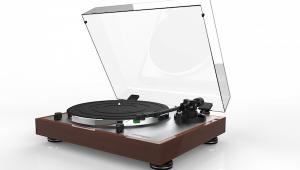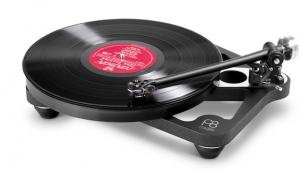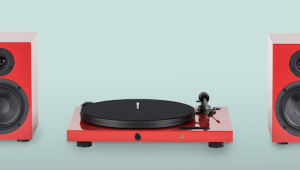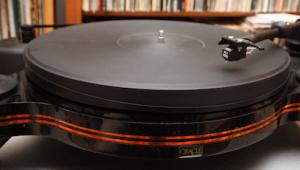The George-Warren Turntable—Well-Made, Sensibly Engineered, Elegant-Looking
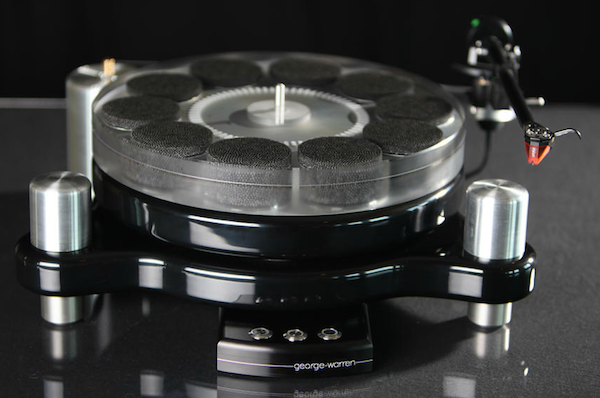
The George-Warren turntable is designed around sensible engineering principles that are well-applied. The split hardwood plinth suspension system consists of a lower platform resting on three equi-distant air-dampened feet and an upper one that rests upon three Visco-elastic polymer pucks strategically placed at 60 degree angles from the air dampened feet.
Both the top of the lower platform and the underside of the upper one have machined cut-outs in which the three pucks fit, producing a secure, well-damped and isolated sandwich. The bottom of the bearing housing, which is built into the upper plinth, fits into an opening in the lower plinth.
The large diameter finely polished, flat-bottomed stainless steel spindle bearing shaft, (nice to see in a ‘table at this price point), fits within a bushing of ultra-high molecular weight (UHMW) Polyethylene that is lubricant impregnated. No additional lubrication will be required for the life of the bearing.
The shaft rests on a UHMW disc sitting upon a stainless steel ball bearing resting at the bottom of the bearing sleeve. The design features no metal-to-metal contact.
The high mass (17.5 pounds) full-sized acrylic platter incorporates ten outer perimeter positioned shot-filled, epoxy encapsulated pockets that increase platter mass, improve platter damping and increase inertia, which makes easier maintaining precise and consistent speed.
Drive is via a high quality, Swiss-made Maxon D.C. motor upon which sits a precision-machined brass pulley. A double loop of 4-6 pound test fishing line drives the platter. The motor housing rests on a pair of large polymer feet purposely placed at one side of the housing bottom to produce an unstable balance so that the motor housing lists to the left, resting awkwardly on its edge.
With the fishing line looped around the platter and pulley (the inexperienced will require a learning curve to accomplish this), one adjusts the distance between platter and motor to cause the monofilament to pull the motor housing towards the platter and into a vertical position so that the housing’s bottom surface sits parallel to the surface upon which it sits. This produces the ideal amount of belt tension. The ingenious system is, by far, the most convenient monofilament-based platter drive arrangement I’ve yet encountered.
The built-in motor control system features a sensor mounted into the top plinth that reads the strobe pattern embedded into the platter bottom and updates the controller, to produce claimed speed accuracy and stability.
The free-standing control unit nests directly below the plinth and includes 3 illuminated buttons: one for 33 1/3, one for 45 and one marked “clean”. The “clean” button bypasses the tachometer control function and increases motor torque, which makes record cleaning possible without the involvement of the speed control system. When you’re finished you push the desired speed button.
The standard version of the George-Warren turntable in painted black or Black Cherry costs $4200 plus $100 for an acrylic arm board cut for your arm. The ‘table is also available in a custom hardwood version that costs $4850 plus $100 for the arm board.
Set Up And Use
Thanks to both the well-written and illustrated instructions and the design’s innate logic and simplicity, setting up the George-Warren turntable is relatively easy as long as you follow instructions, are careful routing the wires and you don’t man handle the electrical connectors.
First you place the upper plinth atop the lower one, making sure the three elastomer pucks rest securely in the upper and lower plinth cut outs, while carefully routing the tachometer reader wires down through the lower plinth opening and to the front.
Attach the acrylic arm board wing to the upper plinth via a single bolt. This allows you to easily rotate the arm board to set pivot-to-spindle distance. Acrylic is my least favorite arm board material and a cantilevered arm board is my least favorite design. However, at this price point it is a reasonable compromise and what counts in the end is the sonic performance.
You then level the ‘table by screwing in or out the three feet until the supplied bubble level shows a perfectly level platter. Next you place the motor in its approximately correct position a few inches from the platter with the two rubber feet parallel to the platter and the screws atop the motor housing pointing towards the spindle so that the motor housing leans away from the platter. Route the wires from the motor under the plinth and to the front.
Next you carefully connect to the back of the control box the strobe wire, the motor wire and the “wal-wart” connector, placing it under the plinth with the buttons accessible.
Finally, you carefully double loop the supplied monofilament drive line and place it around the platter and motor pulley, adjusting as previously described.
After you’ve set up your arm and cartridge, you select a speed and let the platter spin for a few minutes, after which you calibrate the motor controller, which is easily done but I won’t go into it here. Once that’s done, you are ready to play records. The whole thing does not take long and even a novice should easily be able to accomplish at least the turntable set-up if not the cartridge alignment.
Using the ‘table is easy. Push the speed button and it will blink until the platter comes up to speed at which point it will light a solid color blue for 33 1/3 or red for 45. To clean a record first, push the “clean” button and then the speed button.
Rock Solid and Jet-Black Backgrounds
Let’s start with the obvious fact that this is really handsome turntable. You’ll like looking at it almost as much as you enjoy listening to it. And you surely will like what you hear. More than a few visitors owning more expensive ‘tables left saying “I could own that and be done”, though you can’t ignore the contributions made by tone arms, cartridges, phono preamps and the Stillpoints ESS rack that costs more than the ‘table and by a considerable amount. However, the ‘table’s suspension system did an effective isolation job so that taps on the stand and the lower plinth were effectively rejected and did not transmit loud impulse “thumps” through the cartridge and into the speakers. That’s not critical since most of what might be transmitted will be impulse-related, but it’s a reasonably good indicator of the isolation system’s effectiveness
I used both the Mørch DP-8 ($4995) and Kuzma 4Point ($6675-$7090) tone arms. You could argue that using a $4200 ‘table with arms costing more creates an unfair advantage but I would argue that the chain is only as good as its weakest link, particularly in analog audio.
Based upon what I heard here, even if you’re not prepared to spend $10,000 now, you could buy the George-Warren with an inexpensive Jelco arm or with the Rega shown in the lead picture, or with whatever you have now, and as finances permit, upgrade arm and cartridge. The sky’s the limit with cartridges: I auditioned the ‘table first using a Lyra Etna ($6995) and later with an Air Tight PC-1 Magnum Opus ($15,000). Yes, the cartridge’s performance is more arm-related but this combo produced results that gave me a reasonably good idea of what the Air Tight would eventually sound like on the Caliburn.
Listening for “Rhythm’n’pacing”
The ability of a turntable to move the music along rhythmically has somewhat to do with speed consistency but another factor is it’s ability to handle low frequencies without getting them “mixed up”. The amount of energy, especially low frequency energy produced at the stylus/groove interface is great, despite RIAA bass roll-off. That energy travels both into the tone arm and into the record, platter and plinth.
How well the energy gets drained (or not) contributes in great part to the system’s bass performance. Tap on a “lively” plinth and there’s a good chance the bass energy is exciting the plinth, which is then feeding back into the system the bass energy just produced in the groove. The result is soft, “plummy” bass and rhythmic uncertainty.
Some designs use light-weight exotic composites to quickly drain the energy (Rega for instance), while others employ mass to “sink” the energy to keep it from returning. The George-Warren ‘table is a medium mass design of wood that adds a suspension-isolation system that doesn’t “rock” like some spring-suspended designs, yet it still manages effectively to isolate from the outside world and drain energy into the Visco-elastomer pucks.
Clearly the designer carefully balanced the variables (or he was incredibly lucky!) because the George-Warren ‘table is neither slow and over-damped, or too fast and “lightweight” to produce satisfying bass. Instead the ‘table is both fast on its feet (figuratively) and pleasingly midrange-airy, while producing nimble, reasonably well-extended, well-textured bass. The lighter weight Mørch was a better match here than was the heavyweight Kuzma.
The Mørch/GW combo produced fast, nimble, well-textured iron-fisted bass that regularly surprised me with its weight and authority. But more important was the ‘tables overall top to bottom consistency. In a system that costs (don’t ask!), the George-Warren turntable had no apologies to make. Whatever it didn’t do that the “big” ‘tables do in terms of ultimate weight, grip, dynamic authority, ability to “carve out space”, etc. was so evenly distributed I found myself enjoying what I heard and not seriously yearning for the two big rigs sitting on the Harmonic Resolution SXR racks.
Unusual Platterspeed Measurement
For a few years now, I’ve been using the Feickert Platterspeed iPhone app to assess turntable speed accuracy. While it’s extremely accurate as a “strobe” unit to set 33 1/3 and 45rpm, some question its overall accuracy in the other measured areas but I think it’s a “level” playing field since whatever its inaccuracies, they apply to every ‘table measured.
The results here are somewhat troublesome, especially because observationally, the ‘table’s tachometer-monitored speed is stable and even sustained piano notes didn’t noticeably waver (unless the record was pressed eccentrically, in which case no turntable other than the old Nakamichi that corrected for it). Yet look at these results:
The raw frequency variations are well in excess of previous measurements but more troubling is the lowpass filtered results (green line), which compensates for test record eccentricities. It should be a relatively straight line.
If you look at the numerical results the mean frequency is 3151.3Hz, which is close to perfect (3150Hz), meaning the motor control system works as intended. However, both the raw and lowpass-filtered frequency variations are the widest I’ve ever encountered, yet it doesn’t sound as it looks.
So what’s going on here? There are a couple of possibilities. Perhaps the tachometer monitoring is causing the system to widely fluctuate even as it maintains accurate mean frequency (3151.3Hz on a 3150Hz test tone). Perhaps despite the measurements, the “subjective” speed is accurate due in part to a modicum of bearing friction produced by the flat-bottomed bearing contacting the UHMW disc instead of the more typical ball interface? Many savvy designers insist some friction is preferable to a “free-wheeling” bearing that can produce a “runaway platter”.
I don’t have the answer but if the question is, “does the George-Warren turntable sound speed-stable?”, the answer is “yes.”
Conclusion
The considerable time spent with the George-Warren turntable was all pleasure all the time. It produced black backgrounds and was free of obvious colorations like bass bloat, or slow over-damped bass, or “glary” midrange or edgy high frequencies. Its dynamic performance was very good as was the overall image stability. It is better isolated from the outside world than many far more expensive turntables.
While many other turntables at or near its price point challenge it—for instance I look forward to reviewing VPI’s MDF-plinthed Prime, which sells complete with 3D printed arm for $3999—few can match the G-W’s curvaceous wood beauty. Sometimes, under certain married coditions looks matter. If looks and performance matter for you, consider the George Warren turntable. Still, I have to say I’m somewhat bothered by the measured performance (I write that as I’m listening contentedly to the Nimbus Records Direct to Disc Beethoven Piano Sonatas box set Volume 1 performed by Bernard Roberts (Nimbus D/C 901).
Manufacturer's Comment:
I also could not figure out what was going on with your test results. After talking to Bruce Simons, who designed and builds the controller for me, I think we now know whats going on. From the beginning one of my major concerns about using a feedback system to control motor speed was the system constantly "hunting" for the correct speed. The way we solved that issue was to program the controller to not make a correction until it went above or below the frequency range we set. While the system is within this "frequency window" the controller supplies the motor a very even/steady stream of energy and that gives us the low wow & flutter. In a perfect world the speed would stay perfectly steady, but there are numerous external influences on the whole system that will very slightly affect the speed. Over time the mean speed will slowly go up or down until it reaches the frequency window limits and at that time the controller does make a correction.
In my opinion it is better to have a turntable that, while the mean speed may be a fraction above or below the ideal, the wow & flutter numbers are good. That is why this turntable sounds so good even when your test figures show that kind of deviation over a relatively long period of time. In the coming weeks Bruce and I will be discussion the issue and testing whether narrowing the "frequency window" will improve the overall performance of the turntable.
Thanks
George Widman

